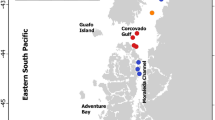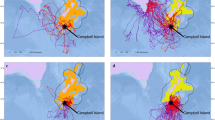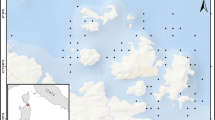Abstract
Cetacean-focused tourism in Taiwan has grown rapidly since 1997. This development, measured in terms of both number of tour boats and visitors, has resulted in many resource management challenges stemming from the absence of regulation and scientific data. To fill this void in empirical evidence, we used 464 sighting records from 2002 to 2005 to model the impact of cetacean-focused tourism. Cox proportional hazard analysis indicated cetacean avoidance responses to cetacean watching boats were strongly associated with pod size, mother–calf pairs, and cetacean-vessel distances. Mother–calf pairs abandoned their avoidance tactic by 55% compared to noncalf groups when tour boats approached. Second, the hazard ratio of abundance was 0.996, suggesting that the odds of encountering avoidance responses by the cetaceans decreased by 42% for every 100-member increase in the cetacean pod size. Last, distances maintained by boats from the cetaceans was positively related to avoidance responses (i.e., less avoidance behavior with closer interaction). Based on our findings, we have the following recommendations: (a) limit vessels from approaching mothers with calves, (b) limit vessels from approaching small groups of cetaceans, (c) reduced avoidance behavior to boat traffic may be a red flag for potential long-term disturbance, and (d) apply the “precautionary principle” based on the best scientific information available in cetacean-based tourism in Taiwan. These recommendations will help contribute to the sustainable development of cetacean-focused tourism in Taiwan.

Similar content being viewed by others
References
Barros C, Correia A, Crouch G (2008) Determinants of the length of stay in Latin American tourism destinations. Tourism Analysis 13:329–340
Basurto X, Ostrom E (2009) Beyond the tragedy of the commons. Economia delle fonti di energia e dell’ambiente 1:35–60
Bauer GB (1986) The behaviour of humpback whales in Hawaii and modifications of behaviour induced by human interventions. Unpublished Ph.D. Dissertation, University of Hawaii
Bejder L (2005) Linking short and long-term effects of nature-based tourism on cetaceans. Unpublished Dissertation, Dalhousie University
Bejder L, Samuels A (2003) Evaluating the impacts of nature-based tourism on cetaceans. In: Gales N, Hindell M, Kirkwood R (eds) Marine mammals: fisheries, tourism and management issues. CSIRO Publishing, Collingwood, VIC, Australia, pp 229–256
Bejder L, Dawson SM, Harraway JA (1999) Responses by Hector’s Dolphins to boats and swimmers in Porpoise Bay, New Zealand. Marine Mammal Science 15(3):738–750
Bejder L, Samuels A, Whitehead H, Gales N (2006) Interpreting short-term behavioural responses to disturbance within a longitudinal perspective. Animal Behaviour 72(5):1149–1158
Benoit-Bird KJ, Au WWL (2004) Prey dynamics affect foraging by a pelagic predator (stenella longirostris) over a range of spatial and temporal scales. Behavioral Ecology and Sociobiology 53:364–373
Birnie P, Moscrop A (2000) Report of the workshop on the legal aspects of whale watching, Punta Arena, Chile. IFAW, Yarmouth Port, MA
Blane JM, Jaakson R (1995) The impact of ecotourism on the St. Lawrence Beluga Whales. Environmental Conservation 21:267–269
Boehmer-Christiansen S (1994) The precautionary principle in Germany-enabling goverment. In: O’Riordan T, Cameron J (eds) Interpreting the precautionary principle. Earthscan, London, UK, pp 31–60
Briggs D (1991) Impact of human activities on Killer Whales at the rubbing beaches in the Robson Bight Ecological Reserve and adjacent waters during the summers of 1987 and 1989. Unpublished Report
Carlson C (2009) A review of whale watch guidelines and regulations around the world version 2009. Unpublished Report, College of the Atlantic
Chou LS (2004) History of the marine mammal study in Taiwan. National Science Museum Monographs 24:129–138
Clemons J (2007) Texas court invalidates Gulf Red snapper plan. The SandBar: Legal Reporter for the National Sea Grant College Program 6.2:13–15
Constantine R (2001) Increased avoidance of swimmers by wild Bottlenose Dolphins (tursiops truncatus) due to long-term exposure to swim-with-dolphin tourism. Marine Mammal Science 17(4):689–702
Constantine R (2002) The behavioural ecology of the Bottlenose Dolphins (tursiops truncatus) of Northeastern New Zealand: a population exposed to tourism. Unpublished Dissertation, The University of Auckland
Constantine R, Brunton DH, Dennis T (2004) Dolphin-watching tour boats change bottlenose dolphin (tursiops truncatus) behaviour. Biological Conservation 117:299–307
Cox D (1972) Regression models and life-tables. Journal of the Royal Statistical Society. Series B (Methodological) 34(2):187–220
Duffus DA, Dearden P (1993) Recreational use, valuation, and management, of Killer Whales (orcinus orca) on Canada’s Pacific Coast. Environmental Conservation 20:149–156
Efron B (1988) Logistic regression, survival analysis, and the Kaplan-Meier curve. Journal of American Statistical Association 83(402):414–425
Fennell DA, Ebert K (2004) Tourism and the precautionary principle. Journal of Sustainable Tourism 12(6):461–479
Government of Canada (2001) A Canadian perspective on the precautionary approach/principle [Electronic Version]. Retrieved 18/09/2008 from http://www.ec.gc.ca/econom/pp_e.htm
Hardin G (1968) The tragedy of the common. Science 162:1243–1248
Heckel GA, Espejel I, Fischer DW (2003) Issue definition and planning for whalewatching management strategies in Ensenada, Mexico. Coastal Management 31:277–296
Hoyt R (2001) Whale watching 2001. International Fund for Animal Welfare (IFAW), Yarmouth Port, MA, USA
IAATO (2003) Marine wildlife watching guidelines (whales & dolphins, seals and seabirds) for vessel & zodiac operations [Electronic Version]. Retrieved June, 2, 2010 from http://www.ecophotoexplorers.com/files/pdf/IAATO-WildlifeGuide03.pdf
IFAW (2008) Pacific islands regional guidelines for whale and dolphin watching. Retrieved June, 1, 2010, from http://www.ifaw.org/assets/Media_Center/Press_Releases/asset_upload_file92_53765.pdf
IWC (2006) Report of scientific committee. International Whaling Commission Meeting 58, Washington, DC
Jansen JK, Bengtson JL, Boveng PL, Dahle SP (2003) Investigation of the potential disturbance of Harbor Seals by cruise ships in Disenchantment Bay, Alaska, May to August 2002, Seattle, WA
Kruse S (1991) The interactions between Killer Whales and boats in Johnstone Strait, BC. In: Pryor K, Norris KS (eds) Dolphin societies: discoveries and puzzles. University of California Press, Berkeley, CA, pp 149–159
Kuo CY (2001) Effect of whale-watching boats on behavior of Risso’s Dolphins (grampus griseus) in the coastal waters of Southeastern Taiwan. Unpublished Master Thesis, National Taiwan University, Taipei, Taiwan
Lauck T, Clark CW, Mangel M, Munro GR (1998) Implementing the precautionary principle in fisheries management through marine reserves. Ecological Applications 8(1):S72–S78
Lejano R, Ingram H (2007) Place-based conservation: lessons from the Turtle Islands. Environment: Science and Policy for Sustainable Development 49(9):18–27
Lusseau D (2004) The hidden cost of tourism: detecting long term effects of tourism using behavioral information. Ecology and Society 9(1):2
Lusseau D (2005) Residency pattern of Bottlenose Dolphins tursiops spp. In Milford Sound, New Zealand, is related to boat traffic. Marine Ecology-Progress Series 295:265–272
Magalhães S, Prieto R, Silva MA, Gonçalves J, Afonso-Dias M, Santos RS (2002) Short-term reactions of sperm whales (physeter macrocephalus) to whale-watching vessels in the azores. Aquatic Mammals 28(3):267–274
Mann J, Smuts B (1999) Behavioral development in wild Bottlenose Dolphin newborns (tursiops sp.). Behaviour Research and Therapy 136:529–566
Norris KS (1994) Comparative view of cetacean social ecology, culture, and evolution. In: Norris KS, Würsig B, Wells RS, Würsig M, Loeffler G (eds) The Hawaiian spinner dolphin. University of California Press, Berkeley, CA, pp 301–344
Nowacek SM, Wells RS, Solow AR (2001) Short-term effects of boat traffic on Bottlenose Dolphins, turisiops truncatus, in Sarasota Bay, Florida. Marine Mammal Science 17:673–688
Ostrom E (2008) The challenge of common-pool resources. Environment: Science and Policy for Sustainable Development 50(4):8–21
Richardson WJ, Green CR, Malme CI, Thomson DH (1995) Marine mammals and noise. Academic Press, San Diego, CA
Shane S, Wells RS, Würsig B (1986) Ecology, behavior and social organization of the Bottlenose Dolphin: a review. Marine Mammal Science 2:34–63
Shelton PA, Sinclair AF, Chouinard GA, Mohn R, Duplisea DE (2006) Fishing under low productivity conditions is further delaying recovery of Northwest Atlantic Cod (gadus morhua). Canadian Journal of Fisheries and Aquatic Sciences 63(2):235–238
Stamation KA, Croft DB, Shaughnessy PD, Waples KA, Briggs SV (2010) Behavioral responses of Humpback Whales (megaptera novaeangliae) to whale-watching vessels on the Southeastern coast of Australia. Marine Mammal Science 26(1):98–122
Stensland E, Berggren P (2007) Behavioural changes in female Indo-pacific Bottlenose dolphins in response to boat-based tourism. Marine Ecology Progress Series 332:225–234
Sutinen J, Boehlert G, Botsford L, Coleman F, Ditton RB, Quinn T et al (2004) Improving the use of the “Best scientific information available” Standard in fisheries management. National Research Council of the National Academies, Washington, DC
Therneau T, Grambsch P (2000) Modeling survival data: extending the Cox model. Springer Verlag, New York
Tseng YP (2003) Whale watching management in Hualien harbor. Paper presented at the 10th annual cetacean ecology and conservation symposium, Taipei, Taiwan
Weinrich M, Corbelli C (2009) Does whale watching in Southern New England impact Humpback Whale (megaptera novaeangliae) calf production or calf survival? Biological Conservation 142(12):2931–2940
Whitehead H (1996) Babysitting, dive synchrony and indications of alloparental care in Sperm Whales. Behaviour Ecology and Sociobiology 38:237–244
Willett JB, Singer JD (2004) Discrete-time survival analysis. In: Kaplan D (ed) The sage handbook of quantitative methodology for the social science. Sage Publication, Thousand Oaks, CA, pp 199–211
Williams RM, Trites AW, Bain DE (2002) Behavioural responses of Killer Whales (orcinus orca) to whale-watching boats: opportunistic observations and experimental approaches. Journal of Zoology 256:255–270
Würsig B, Wells RS, Norris KS (1994) Food and feeding. In: Norris KS, Würsig B, Wells RS, Würsig M, Loeffler G (eds) The Hawaiian Spinner Dolphin. University of California Press, Berkeley, CA, pp 216–231
Yu WJ (2000) Influence of whale-watching boats on behavior of cetaceans at Haulien, Taiwan. Unpublished Master Thesis, National Dong Hwa University, Hualien, Taiwan
Author information
Authors and Affiliations
Corresponding author
Rights and permissions
About this article
Cite this article
Tseng, YP., Huang, YC., Kyle, G.T. et al. Modeling the Impacts of Cetacean-Focused Tourism in Taiwan: Observations from Cetacean Watching Boats: 2002–2005. Environmental Management 47, 56–66 (2011). https://doi.org/10.1007/s00267-010-9567-2
Received:
Accepted:
Published:
Issue Date:
DOI: https://doi.org/10.1007/s00267-010-9567-2




